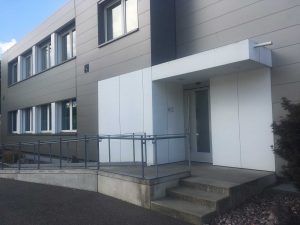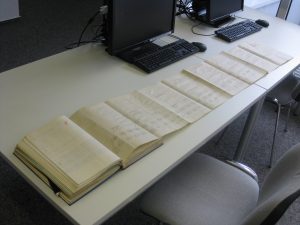
The doors open Monday through Friday at 08:00 precisely! There are always two or three people standing around waiting to be let in.
Last week Morten visited the German military archive in Freiburg again, his third visit in the last year. The trip was originally planned to be a three-day stay, but the list of files for both the Hs 123 and Air War Courland book projects, as well as various articles, kept growing. In order for Andrew, Adam and Morten to move forward and hopefully complete all the research projects, the visit was extended a day. That resulted in an additional 2.500 document pages copied, so it was a day well spent!
The aim of this research trip was to ‘tie up some loose ends’ and complete the copying of some file series, but also to look into the contents of new file series and individual files discovered via the search engine during the past year. For the Hs 123 project, it was most notably Legion Condor files that needed to be investigated, as the role of the Hs 123 in Spain is only partially covered. Also, Flivo records from Heer files needed to be browsed and in many cases copied, as there are bits and pieces in there that can help shed light on operations by the Hs 123. For the Courland project, high-level headquarter files and personnel files were viewed.

Each visitor has their ‘own’ shelf. Fortunately, this photo was taken at the end of Morten’s visit … empty. Just over 10.000 pages were copied.
Work at the archive is enjoyable, but the ten hours of photographing file pages every day for three or four days takes a toll on the back and shoulders. Lunch breaks are kept to ten minutes. Using the archive is easy and the staff are very friendly – most of them speak or understand English. Morten pre-ordered 25-30 files, and they were ready upon his arrival on Monday morning. Monday also turned out to be the most productive day in terms of the number of pages photographed – approximately 3.000. On the other three days the average was about 2.500 unique pages copied. Some of the time in the archive was spent on the available computers searching for personnel files. They are not allowed to be photographed, but strangely enough, copies can be ordered via the Selke Fotoservice. Regardless, it is often very interesting to browse these personnel files, which can contain a very wide variety of papers, dispatches, notes, evaluations, comments regarding promotions etc. Another obstacle can be files that are unavailable because they are undergoing conservation. That can take more than a year, so patience is essential.

Some files, like this airfield command war diary, surprised by containing photographs of important events.
Below are a few examples of files and the different ‘shapes’ they take. The odd-sized pages or files significantly reduce the copying speed, but often present information that provides a better overview and understanding of the topic. So all-in-all, it is worth the extra time to carefully unfold, photograph, and fold it back. For many of these pages the paper is fragile and can break or rip easily, so you have to be cautious.
In conclusion, the trip was a success, but there are still more interesting files to be looked into. In particular, once the Hs 123 and Courland projects are completed, the Fw 190 Fighting Over Southern Italy book is coming up next. That will require additional research trips to Freiburg, which both Andrew and Morten always look forward to. However, that is still some years into the future.







